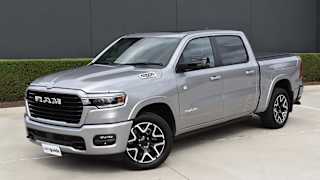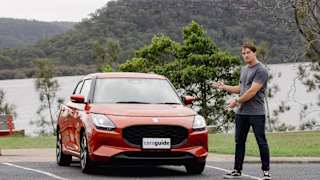Lexus surprised us a bit with its choice of test roads for the LX’s launch. As well as some twisty bitumen which might not, on the surface, have seemed the most LX-friendly terrain, the launch also threw in some steep if not otherwise too taxing off-road work.
The steep downhill section highlighted the fact that the LX has probably the best hill-descent control we’ve sampled. Not only is it simple to use with speed variation via the rotary knob that otherwise controls the drive modes, it’s also consistent and doesn’t stumble or lock-up wheels and bang brake calipers intermittently.
The second surprise was how well 2.6 tonnes of luxury off-road SUV handled the winding blacktop. It’s no performance-oriented SUV with its live rear axle and off-road-worthy suspension settings, but it can be hustled along in a pretty tidy manner if you concentrate and keep it flowing.
Beyond that, it was pretty civilised at everything else, too, and although it’s not a compact vehicle by any means, the cameras and sensors ensure that it’s not too much of a brain-teaser to park.
The LX seems to have slightly better noise suppression than the LandCruiser on which it’s based and the diesel version doesn’t seem quite as vocal under load. That said, it’s still very quiet and when rolling along at highway speeds and low engine revs, even the diesel is tomb-like in its silence.
But the petrol is next-level refined. There’s a small degree of engine raspiness when you rev the petrol V6 hard (and you won’t mistake it for a V8) but it’s a sophisticated soundtrack and, at a steady throttle, the petrol LX is even more silent.
The two engines have vastly different torque curves, but the 10-speed transmission is so on top of things that it can tailor its shift-pattern to make the absolute most of whatever torque and power are being produced. You can just feel the transmission holding a gear a little longer when the driver dials up max thrust, but in the interests of getting a heavy vehicle moving swiftly, using a clever transmission is the smart, modern way to do it.
Steering is a fraction light to be completely tactile, but that’s a function of the off-road abilities, and we’re pleased to report that the turning circle is very good given the exterior dimensions and makes tight city work much easier.
The shift paddles are, ironically, likely to be of most benefit when off-road and it’s here that the LX lays the SUV pretenders to waste. With low-ratio gears in the transfer case and that clever 10-speed, the LX will climb up some amazing places. It’s fair to say that, like all good off-roaders, you’ll run out of brave pills before the LX runs out of talent.
And while the suspension does a good job off-road, the live rear-axle and independent front suspension also combine pretty well on the blacktop. There’s some initial thump on pattery bumps that are felt more than heard. But as the bumps get bigger, the LX gets even better at dispatching them.
The variable ride height feels like air-suspension but is actually a clever hydraulic adjustment to the dampers to increase their length and, therefore jack the vehicle up for off-roading. Strangely, the ride seems to become a fraction firmer (and we mean a fraction) as the height cranks up, but most owners will never notice it.
What they will notice is the composure that the LX has in most settings. No, it’s not the fastest or tidiest handling SUV out there, but it’s well beyond good enough. And off-road? Very, very little is likely to touch it.






